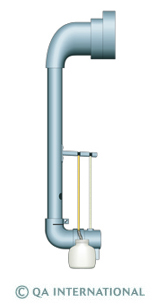Weather forecast: land meteorological station
What will the weather be tomorrow? To answer this question, numbers of measures are collected every day in space (weather satellite), in the sky (aircraft, sounding ballon), on the oceans (buoy, boat) and at ground level (radar, land station).
Daily, thousands of weather stations measure wind’s direction and strength, air temperature and humidity, sunshine hours, barometric pressure and precipitation. These observations are transmitted to the World Meteorological Organization and used to create computer models from which weather forecasts are made.
Measuring sunshine hours
Two different instruments are used to measure the quantity of solar radiation and number of sunshine hours. The pyranometer records diffuse radiation from the sky measured by a thermopile. It is equipped with a shadow band that blocks direct solar radiation. The heliograph consists of a glass sphere that focuses solar radiation in a manner similar to a magnifying glass. The length of the burn marks on the graduated chart placed under the sphere indicates when the Sun shines and for how long.
Measuring precipitation
The amount of rain is determined by measuring the height of water that accumulates in a container called a pluviometer. Rain is collected through a funnel that directs it into a graduated test tube.
The pluviograph records the amount of rain that falls throughout a day. A tipping bucket emits an electrical impulse every time the weight of the accumulated water makes it tip and empty the water into a receptacle.
The snow gauge is simply a container. The snow that accumulates in it is melted, and the water obtained is measured in a test tube. A recorder notes when the bucket emits an electrical impulse.
Measuring pressure
The standard instrument for measuring atmospheric pressure is the mercury barometer. It consists of a tube filled with mercury resting in a reservoir that is also filled with mercury. As the mercury is exposed to variations in the weight, and thus pressure, of air, the mercury column rises or drops in the tube. The aneroid barograph records variations in atmospheric pressure. The pressure exerts force on an evacuated capsule. As the capsule contracts or expands, its movement is transmitted to a recording pen, which traces a line on a revolving paper-covered cylinder.
Measuring the wind
Wind strength and direction are measured with two different instruments. The anemometer, with cups revolving around a mobile axis, records wind speed and transforms it into a measurable speed. The weather vane indicates wind direction.
Measuring the temperature
Ambient temperature is measured with a thermometer. A liquid substance, usually mercury or alcohol, is enclosed in a graduated tube. The liquid expands when the temperature rises and contracts when the temperature drops. Minimum and maximum thermometers record the highest and lowest temperatures in a day due to a system of movable pointers.
Measuring humidity
Atmospheric humidity can be measured in two different ways. The psychrometer uses two thermometers, one wrapped a damp cloth. Evaporation causes cooling, which is measured by comparing the values shown on the thermometers. This information is used to calculate relative humidity

To record humidity in the air, the hygrograph uses human hairs, which get longer in humid weather. A stylus attached to the hairs continuously transcribes variations in humidity onto a roll of paper.
Some of these instruments are placed in a Stevenson shelter, a white-painted box raised 1.2 m above the ground. The sides of the shelter have louvers that allow air circulation and keep solar radiation from directly affecting the instruments.





